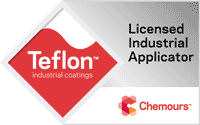Choosing an industrial coating requires careful consideration of each option’s unique advantages and disadvantages. Different coatings have different aesthetic finishes, curing and drying times, environmental impacts, levels of durability, and other properties.
We will discuss three main types of metal finishes—anodizing, painting, and powder coating—as well as their respective strengths and weaknesses, applications, and other considerations to help you decide which is the best for your project.
Anodized Coating
Anodizing is an electrochemical process that results in an anodic oxide surface finish on a metal part, usually aluminum. The finish is corrosion-resistant, durable, and visually pleasing.
Anodizing involves submerging an aluminum part in an electrolyte solution containing a cathode that passes an electrical current through the solution. The aluminum part acts as an anode, binding to the oxygen ions released from the electrolyte solution. The result is a controlled oxidation of the part’s surface.
Anodizing provides the following benefits:
- Eliminates peeling and chipping
- Brilliant metallic finish
- Easily cleaned with detergent and abrasives
- Quick lead times
- Eco-friendly, emitting no volatile organic compounds (VOCs)
- Low maintenance
- Allows for secondary processes
The primary drawbacks of anodizing are its susceptibility to acidic pollutants and variations in color due to the coating’s translucence.
While aluminum is the most suitable material for anodizing, it also works on several nonferrous metals like titanium and magnesium. Anodized aluminum withstands abrasive cleaners and frequent impact, making it ideal for high-traffic areas. These are just some applications that rely on anodizing:
- Computer hardware
- Cookware
- Elevators
- Satellites
- Motorcycle parts
- Flashlights
Industrial Paint Coating
Industrial paint coatings are liquid coatings made from a solvent, resin, and pigment. Tools, vehicles, and pipes often rely on paint coatings. The benefits of industrial paint coating include:
- Variety of finishes
- Corrosion resistance
- Abrasion resistance
- Does not require an oven—suitable for heat-sensitive products
- Thin coatings
- High transfer application
- Thermal protection
- Energy efficiency
- Greater control over aesthetics
Potential drawbacks of performing liquid paint coatings are:
- Long curing time: a few hours without heat followed by one hour of heat, then overnight drying
- Spray booths need to be vented outside the work area
- Higher setup costs
- Humidity can compromise durability and corrosion resistance, causing delamination and blistering
Custom Powder Coating
Custom powder coating utilizes dry, free-flowing powdered thermoset or thermoplastic materials to finish a substrate. Using electrostatic spray deposition, operators adhere the powder to the electrically grounded metal workpiece. Operators can also dip heated metal parts into a fluidized bed of the powdered material to produce similar results. In both methods, the powder dries and the part cools quickly, resulting in a hard, smooth finish.
Compared to anodizing and liquid paint coating, powder coating is the most well-rounded, versatile, and sustainable solution for most projects. It offers the following benefits:
- Quicker processing, drying, and curing time than liquid coatings
- Produces textures and finishes not possible with liquid paint coating
- Abrasion and impact resistance
- Corrosion, chemical, and UV resistance
- Ideal edge coverage and color consistency
- Nonflammable
- Good electric insulation
- Involves zero solvents
- Eco-friendly, emitting no VOCs when oven-cured
- Cost-effectiveness
Powder coating has several drawbacks when it comes to small-batch parts. The powdered material is custom ground from plastics in the client’s desired color. The minimum consignment makes it cost-prohibitive for small batches. Each powder coating is also tailored to the client’s specific mechanical and physical characteristics, so coatings cannot be mixed to make different colors.
Powder coating materials include:
- Thermosets and thermoplastics
- Antimicrobial formulas
- Polyolefin (Plascoat® PPA)
- Halar® ECTFE
- Fluoropolymers (ETFE, FEP, PFA)
- Nylon
- Epoxy
- Polyester and polyester TGIC
Powder coating is suitable for metal, glass, plastic, medium-density fiberboard, and other substrate materials. An example of an application where powder coatings create an appealing and durable finish is commercial trashcans.
Experienced Custom Powder Coating Services from Matrix Coatings
There are several options for industrial coatings, but powder coating is the most effective and environmentally friendly approach for the broadest range of applications. Matrix Coatings has been recommending and performing powder coatings since 1964. We are ISO 9001 and AS9100 registered, and we are Florida’s exclusive Licensed Industrial Applicator (LIA) of Teflon™ powder coatings.
We have worked with leaders in various industries, including food processing, plastic extrusion, lawn and garden, and automotive. Contact us to speak with an industrial powder coating expert about your needs.
